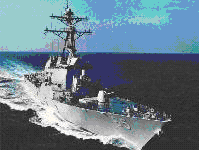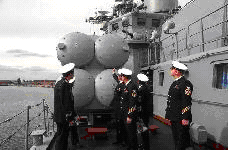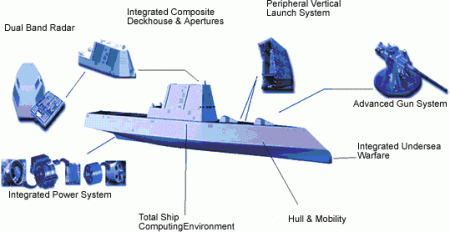US Navy’s Fleet increasingly Irrelevant in Fight against Terrorism and Rogue States

One of the oldest maxims in warfare is the military always prepares to fight the last war. When looking at the bulk of the US Navy, nothing could be truer.
For the navy, the problem is even worse than for other services. Not because the navy has bad planners, but because of the high unit cost and long lead time to build new forces. Consider this: just to get an aircraft carrier afloat might take twenty years from ordering to shakedown cruise. These floating airports cost billions of dollars, and once started can’t be stopped. In the water they have a service life of more than 20 years, huge crews and extensive overhauls to maintain them up to date with the latest technology. They burn money like their jets burn aviation gas – by the tanker full.
The current US navy has 12 aircraft carriers (CV, CVN), 18 nuclear armed ballistic missile subs (SSBN), 50 attack subs (SSN) and a host of cruisers, destroyers, frigates, landing and command ships – about 350 ships in all. It’s hard to see the need for this enormously expensive blue water fleet. Designed to duel a Soviet blue-water fleet that no longer exists, who is it going to fight?
Worse, terrorists and 3rd world countries have routinely done serious damage to these billion dollar high-tech missile magnets. In 2000, a couple of guys in a low-tech speedboat full of explosives nearly sank the destroyer USS Cole at dock in Aden killing 17 sailors in the process. In 1987, an Iraqi Mirage F1 put two Exocet AM39 sea-skimming ship killers in to the frigate USS Stark with complete impunity. The then US-ally Sadam Hussien had the pilot beheaded for his error – the Iraqi pilot thought he was targeting an Iranian tanker. During the Falklands war the British learned first hand how vulnerable ships were. Argentinean’s flying French made Mirages armed with Exocets sank a frigate – the Sheffield - and a large containership – Atlantic Conveyor. They even lost several ships to unguided 500lb bombs dropped by US made A4 Skyhawks.
The USS Vincennes, an Aegis-class cruiser - considered a capital ship - shot down Iran Air Flight 655 in 1988 which resulted in the deaths of over 290 innocent passengers. This just proves how much of a bull in the china shop one of these ships can be when it has no real enemy. At the time it was engaging high-speed patrol boats with its cannon and misidentified the Airbus for an Iranian F-14. USS Vincennes had one of the most modern radar systems in the world, yet was unable to detect the difference between commercial and military air traffic. Imagine how it would fare against several supersonic, sea skimming missiles.
Admirals at the navy are not stupid – already plans are on the drawing board for new types of ships better equipped to deal with a changing threat environment. Radars and antimissile systems are at the top of the list for major improvements.
One of the most important new roles is one of surveillance. Once relegated to launching Harpoon anti-ship missiles and hunting down enemy subs, ships like the new Arleigh Burke destroyers bristle with communications interception gear. Historically and still the most effective naval weapon – the mine – has received high priority for both laying and countermeasures. A single, 100 thousand dollar mine can send a billion-dollar ship to the bottom in just minutes.
In order to maintain a large fleet and lower costs, the navy has embarked on a program to automate large portions of the previously labor-intensive job of maintaining a warship. Everything is computerized and controlled from a Combat Information Center deep within the ship. Crew sizes have been reduced 25% since the 70s.
Less emphasis is placed on sheer speed and attack value, more on reliability, easy of maintenance and economy. Corrosion-resistant steel has come back into use as lightweight aluminum structures tend to melt and even burn when hit by a missile – mostly caused by unused fuel, not the high explosive warhead.
Stealth to protect against radars has also been improved in the wake of a new generation of water skimming supersonic antiship missiles. But the basic cheap-missile vs. expensive, slow and vulnerable-ship logic remains.

Witness the Russian Navy’s SS-N-22 Sunburn. It has been called "the most lethal missile in the world today." Speed: Mach 2.5 – faster than a bullet, warhead: 750lbs. conventional or 200 kiloton nuclear. These puppies make Exocets (so successful in the Falklands) look like pop bottle rockets in comparison – they actually jump around on terminal phase to avoid missile countermeasures - the British Goalkeeper or US Phalanx close in defense systems require a steady target to lock on. They cost less than a fighter and just one armed with a nuclear warhead could sink any aircraft carrier.
Conventionally configured, one Sunburn could turn an Arliegh Burke-class destroyer in a smoldering, sinking pile of scrap. This missile is found Russian on “Sovremennyy” destroyers (eight missiles each) and on “Tarantul” (Tarantula) III patrol ships (four missiles each). China recently bought 2 Sunburn armed destroyers to give its Pacific Fleet an edge in any conflict with the US.
These new missiles are the primary reason carriers and capital ships try to stay at least 100 miles from the shore and other ships – there is no known defense against them once launched.
The navy’s worst nightmare would be to have to deal with several Sunburn-armed subs which could easily get within strike range of a carrier task force before being detected.
One of the most historically deadly naval weapons has been the torpedo. The Russians have developed a torpedo that travels at jet speed underwater with a new rocket-based propulsion system. Rumors place the blame the sinking of the ballistic missile sub Kursk on a test firing of this dangerous new weapon. Since this technology could effectively change the balance of naval power, the US navy is developing similar technology.

Trent Lott gleefully announced his state will be building some of the first of 8 next generation destroyers. At each unit over a billion dollars apiece, this new hull will be forced into three different roles: littoral (shallow waters and rivers), guided missile cruiser to protect carriers and destroyer to hunt subs, and picket duty or patrol.
Note how much attention has been paid to making the ship less visible to radar – all exterior surfaces are smoothed and angled to present the smallest possible profile – almost looks like a surfaced sub, its primary enemy.
Anyway, it should be interesting to see what the Admirals come up with to protect the blue-water navy they worked so hard to get. As long as jobs, contractor profits, pork barrel politics and creative propaganda having anything to say, they should have no problems keeping their expensive toys out of the scrap yard.
And if there is a serious shooting war, lets hope they get in the first shoots – if not, the US Navy could find its self on the receiving end of another Pearl Harbor.
By Philip Dunn, Copyright 2006 PhysOrg.com















